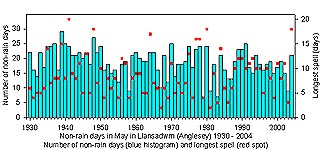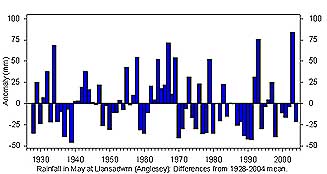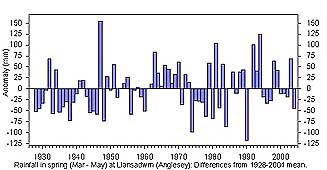
Llansadwrn (Ynys Môn) Weather Station
Wx-Watch
from the observer's notebook

 |
Llansadwrn (Ynys Môn) Weather Station
|

|
Rainfalls in March (55.1 mm) and April (50.5 mm) were below the long-term average (78% and 81% respectively) so the wet spell in the first 8 days when there were 39.3 mm was welcomed by gardeners and farmers. But then followed one of the longest dry spells in May for years, the month ended with 47.0 mm, 72% of average. Overall it was the driest May since 1998, that had only 25.3 mm, and was not exceptional as it ranked 25th driest on record since 1928. It brought the rainfall for the spring months (March - May) to 152.6 mm, driest since 1990 that had a total of only 80.2 mm. This ranked 16th driest on record so was, perhaps, more interesting.
During the 18-day spell between the 9th and 26th there were 13 dry days, trace amounts on 4 days and 0.1 mm on 1 day. It qualified, therefore, as an absolute drought. The terminology is no longer used officially, it required a minimum of 15 days none of which was credited with 0.2 mm (0.01 inches), or more (the rain day). It was introduced by G. J. Symons in 1887 and published in British Rainfall ¹, but ceased publication in 1968. Another term used was dry spell, this requires a period of at least 15 consecutive days none of which is credited with 1.0 mm (0.04 inches), or more (the wet day). More abstract was the partial drought that was defined as 29 consecutive days when the mean of the daily observations did not exceed 0.2 mm (0.01 inches).
Non-rain days and longest spell
 Daily rainfall records at Llansadwrn started in 1928. Original records, in the hand of the observer of the day, were examined. In the first 2 years, after the first raingauge was installed, the observations did not properly record traces, and small amounts, so they have been excluded. Following inspection by the Met Office the correct procedure was adopted by 1930. In each May, from 1930, the number of non-rain days (nil, trace or 0.1 mm) and spells of 3, or more days, were counted. Records from 1928 to 1978 were reported in inches and from 1979 onwards in mm. Fig. 1 shows the number of non-rain days (histogram) and the number of days of the longest spell (red spots). The last absolute drought in May occurred 24 years ago in 1980, it too lasted 18 days. It was necessary to look back 56 years to 1948 to find another of 18 days and lastly 63 years to 1941 to find the highest 20 days. The years 1977 and 1988 both had 16 days, 1964 had 17 days while 1939 had 15 days. So there have been 8 in Llansadwrn, that comply with the definition, in the last 74 years, a frequency of about 1 in 9 years. Close runners-up were 1935 and 1984 with 14 days. A closer examination showed that several years had more than one non-rain day spell of 3 or more days. In 1935 there were spells of 14 days (1st to 14th) and 8 days (20th to 27th). In 1939 there were spells of 12 days (1st to 12th) and 15 days (17th to 31st); this spell was even more remarkable because it went on until the 11th June (25 days). In recent years May 1988 had spells of 10 + 7 days; 1989 12 + 7 days; and 1990 12 + 6 days.
Daily rainfall records at Llansadwrn started in 1928. Original records, in the hand of the observer of the day, were examined. In the first 2 years, after the first raingauge was installed, the observations did not properly record traces, and small amounts, so they have been excluded. Following inspection by the Met Office the correct procedure was adopted by 1930. In each May, from 1930, the number of non-rain days (nil, trace or 0.1 mm) and spells of 3, or more days, were counted. Records from 1928 to 1978 were reported in inches and from 1979 onwards in mm. Fig. 1 shows the number of non-rain days (histogram) and the number of days of the longest spell (red spots). The last absolute drought in May occurred 24 years ago in 1980, it too lasted 18 days. It was necessary to look back 56 years to 1948 to find another of 18 days and lastly 63 years to 1941 to find the highest 20 days. The years 1977 and 1988 both had 16 days, 1964 had 17 days while 1939 had 15 days. So there have been 8 in Llansadwrn, that comply with the definition, in the last 74 years, a frequency of about 1 in 9 years. Close runners-up were 1935 and 1984 with 14 days. A closer examination showed that several years had more than one non-rain day spell of 3 or more days. In 1935 there were spells of 14 days (1st to 14th) and 8 days (20th to 27th). In 1939 there were spells of 12 days (1st to 12th) and 15 days (17th to 31st); this spell was even more remarkable because it went on until the 11th June (25 days). In recent years May 1988 had spells of 10 + 7 days; 1989 12 + 7 days; and 1990 12 + 6 days.
 Total rainfall in May (1928 - 2004)
Total rainfall in May (1928 - 2004)
Rainfall in May 2004 was 47.0 mm and to see how it compared with previous Mays differences from the 1928 - 2004 average (the anomaly) were plotted for each year from 1928 in Fig. 2. May 2004, following the wettest May on record in 2003, was driest since 1998 but not exceptionally dry ranking only 25th. Driest was in 1939 with 19.0 mm. There have been 3 runs of 5 consecutive dry Mays. The last and driest was between 1987 - 1991 with an aggregate of 154 mm; between 1935 - 1939 with an aggregate of 201 mm; and between 1948 - 1952 with 242 mm.
Total rainfall in spring (1928 - 2004)
 Rainfall in the spring of 2004 totalled 152.6 mm, ranked 16th and was the driest since 1990. Differences of each spring's rainfall total from the 1930-2004 average (the anomaly) are plotted in Fig. 3. The driest springs were 1990 that had only 80.2 mm, followed by 1974 with 99.6 mm and 1984 with 110.7 mm. The year of 1976 , that went on to have the driest summer on record (70.1 mm), had one of the wettest springs with a total of 169.1 mm.. But the wettest was 1947 and that had 352.0 mm, and the second wettest 1994 with 322.4 mm. The latter is included in a group of 3 wet springs 1992 (298 mm), 1993 ( 239 mm). A group of 9 consecutive wetter than average springs occurred between 1962 and 1970. Of these 1970 was the wettest with 259.1 mm. There was a run of 6 dry springs from 1935 to 1940, the driest of them was 1938 with 126.0 mm. Another group of 5 consecutive dry springs occurred between 1974 and 1978, here the driest was 1974 with 99.6 mm.
Rainfall in the spring of 2004 totalled 152.6 mm, ranked 16th and was the driest since 1990. Differences of each spring's rainfall total from the 1930-2004 average (the anomaly) are plotted in Fig. 3. The driest springs were 1990 that had only 80.2 mm, followed by 1974 with 99.6 mm and 1984 with 110.7 mm. The year of 1976 , that went on to have the driest summer on record (70.1 mm), had one of the wettest springs with a total of 169.1 mm.. But the wettest was 1947 and that had 352.0 mm, and the second wettest 1994 with 322.4 mm. The latter is included in a group of 3 wet springs 1992 (298 mm), 1993 ( 239 mm). A group of 9 consecutive wetter than average springs occurred between 1962 and 1970. Of these 1970 was the wettest with 259.1 mm. There was a run of 6 dry springs from 1935 to 1940, the driest of them was 1938 with 126.0 mm. Another group of 5 consecutive dry springs occurred between 1974 and 1978, here the driest was 1974 with 99.6 mm.
ACKNOWLEDGEMENTS
Without the records of the former Llansadwrn observers, Mr C. Panton Vivian, Mr Dic O'Connor and Mr Anwyl E. C. Morgan, this account would not have been possible.
Mr Ivor McLean, former Senior Meteorological Officer at RAF Valley, and the Librarian of the Meteorological Office at Bracknell (now Exeter) were able to provide some missing records.
REFERENCES
1. Meteorological Office. Vs. to 1968. British Rainfall, Part 1. HMSO
These pages are designed and written by Donald Perkins. Copyright © 2004Document dated 8 June 2004.http://www.llansadwrn-wx.co.uk |